Chapter 1 - The Human Body
1/63
There's no tags or description
Looks like no tags are added yet.
Name | Mastery | Learn | Test | Matching | Spaced |
|---|
No study sessions yet.
64 Terms
Anatomy
The various structures of the body, and their relationship to one another
Gross anatomy
Structures visible to the naked eye
What is connected to what in which cavity
Regional vs Systemic
Microscopic anatomy
Structures that are microscopic
Not visible to the naked eye
Cells and tissues
Cytology vs histology
Physiology
How these individual body parts work (or function) on a normal level
Fixed in function
Mostly cellular and molecule
Cell are the ones producing products
What is the relationship between structure and function?
Principle of complementarity of structure and function
What a structure can do is dependent on its form
Change structure → change function
Structural organization of the human body
Chemical
Cellular
Tissue
Organ Level
Organ System
Organismal Level
Chemical level
Atoms combine to form molecules
The smallest structural organization
Cellular level
The smallest unit of life
The 2nd structural organization
Tissue level
Aggregation of living cells that carry out a similar function
Four basic types
The 3rd structural organization
Types of tissue
Muscle
Epithelial
Nervous
Connective
Organ Level
2 or more tissues operate together to preform a certain function
The 4th structural organization
Organ System
Multiple organs work together to accomplish a purpose
The 5th structural organization
Organismal Level
All organ systems working together to keep the organism alive
(you as a person)
The last structural organization
Necessary Life Functions
Maintaining boundaries
Movement
Responsiveness
Digestion
Metabolism
Excretion
Reproduction
Growth
Maintaining Boundaries (as a necessary life function)
At the cellular level
Plasma membrane to keep contains of a cell together
At the organismal level
integument/skin
hold everything in
prevent exposure from environment and bacteria/viruses
Movement (as a necessary life function)
Cooperation of skeletal and muscular systems to coordinate actions
Conscious/voluntary
Skeletal muscular tissues
Not conscious/involuntary
Smooth muscle tissue (hallow organs)
Cardiac muscle tissues
Responsiveness/Excitability (as a necessary life function)
Sensing environmental changes both internally and externally and responding to them
Nervous system is primarily involved with excitability
Neurons
Highly specialized to be excitable
How brain perceives information and communicates with rest of body
Muscle tissue cells
Have to respond quickly to allow us to move fast
e.x: if we touch a hot stove
Digestion (as a necessary life function)
Absorb nutrients
Food is broken down to simple molecules to be absorbed to blood and delivered to various tissues
Metabolism (as a necessary life function)
Sun of all chemical reactions in organism
Catabolism
Break down
Take larger molecule and breaking it down into smaller part
ex: protien to amino acids
Anabolism
Build up
Take smaller molecules and combining them to make larger molecule
ex: amino acids to protein
Cellular respiration
Produce ATP
ex: glycolysis, Krebs Cycle, electron transport train,
Excretion (as a necessary life function)
Removal of waste produced during digestive and metabolic function
Forms
solid waste (digestive)
exhale (respiratory waste CO2)
nitrogenous waste (urinary system)
Built up waste can
kill a cell
interfere with cellular function
Reproduction (as a necessary life function)
Cellular level
cells must divide for organism to survive
Organismal
production of offspring
species survival
Growth
Increase in the number of body cells
Increase in size of individual cells themselves
Building must occur faster than breakdown
rate of anabolic > rate of catabolic
difference between survival need and life functions
The survival needs are required to be able to carry out life functions
Survival Needs
Nutrient
Oxygen
Water
Endothermy
Atmospheric Pressure
Nutrients (as a survival need)
Brought into body by ingestion
Includes macro nutrients: carbohydrates, fats, proteins
Need to bring them in at large amounts throughout the day
Includes micro nutrients: vitamins and minerals
Vitamins important for chemical reactions
e.g: B12 necessary for ATP products
Minerals (iron, zinc, calcium) are structural
Oxygen (as a survival need)
Cells can only survive a few minutes without oxygen
Electron transport train requires oxygen to make ATP
Electron transport train supplies >50% of our APT
Water (as a survival need)
We are 60% water
Provides environment for chemical reactions
Primary solvents for chemical reactions to occur in and use as part of the reactions
Hydrolysis
Fluid base for secretions and excretions
Difference between a secretion and excretion
Secretions
Removes something it produces
Excretion
Waste
Endothermy (as a survival need)
Body temperature must be maintained for chemical processes to occur
We produce our own body heat
Atmospheric Pressure
Required for respiratory function
Breathing and gas exchange
Changing altitude can effect humans
e.x: altitude sickness
Suddenly breathing in less oxygen concentration (thin air)
Homeostasis
Maintenance of a consistent internal state despite changes in external environment
Maintenance is not a static state, hover in a range of expectable levels
Accomplished by the work of virtually all organ systems
Control of homeostasis
Mostly regulated by central nervous system (almost always the brain) and the endocrine system (hormones)
Variable: what organ or function is being controlled or regulated, 3 parts involved in variable control
Receptor
Control Center
Effector
Controlled by negative feedback mechanism or positive feedback mechanism
Receptor (in control of homeostasis)
Some type of cell that receives information about the variable and sends a message to control center
Control center (in control of homeostasis)
Almost always the brain, sometimes the spinal cord
receives message from receptor, interpret it, then send out a response to an effector
Effector (in control of homeostasis)
Receives response from control center and carries it out
Negative feedback mechanism
Cause the variable to change in a direction that is opposite of the initial change
Prevents large changes, more stable
e.x: thermoregulation, most hormones
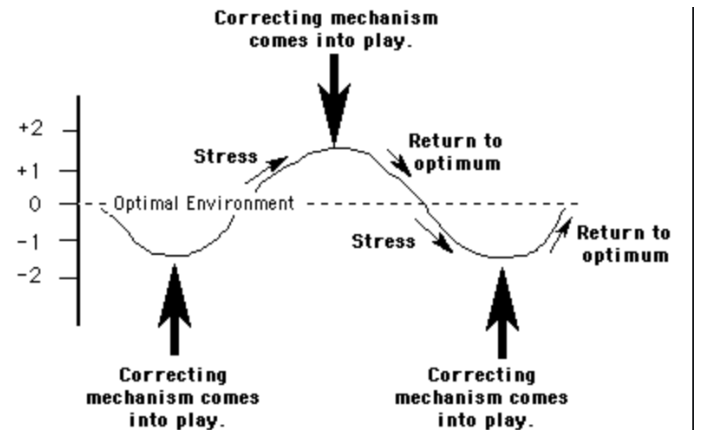
Positive feedback loop
Cause the original change of the variable to be enhanced (accelerates the change)
Way less common, used in emerencys
Does not control events that require frequents, small adjustments
e.x: labor, blood clotting
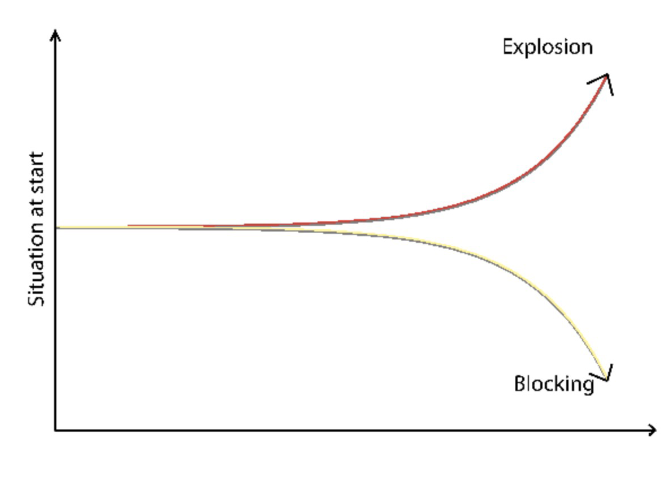
Imbalances in homeostasis
Causes:
aging leads to homeostatic imbalance
control systems become less efficient, making us more susceptible to disease
cascade of events caused by positive feedback mechanisms can overpower negative feedback mechanisms
Leads to disease or sickness
Reference point: anatomical position
Right vs left is always viewed in terms of the person being observed. not your own
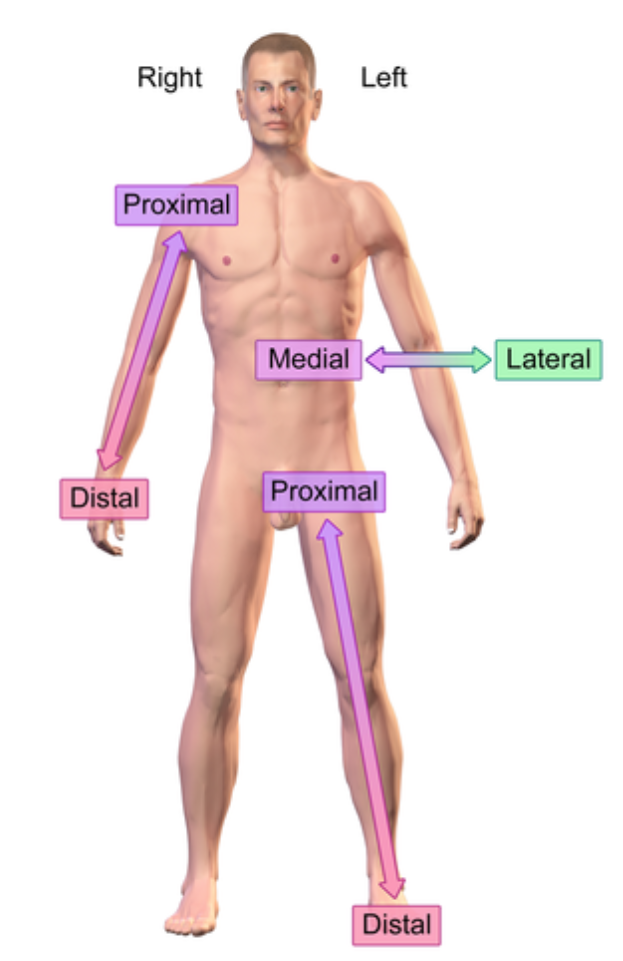
Dorsal (posterior) (anatomical term)
Backside
e.x: vertical column

Ventral (anterior) (anatomical term)
Front/belly side
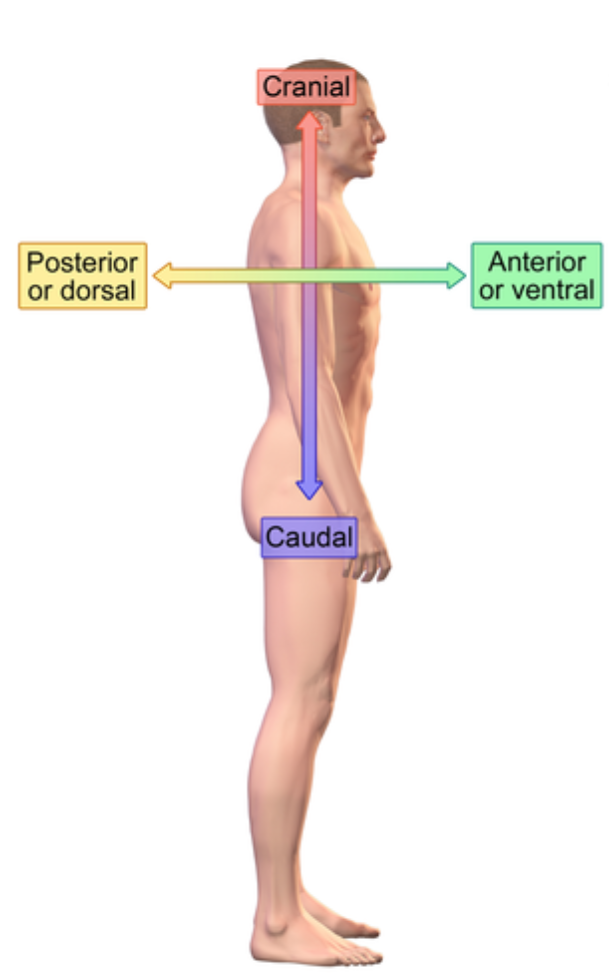
Lateral (anatomical term)
Further from the midline
e.x: ear is lateral to the eye
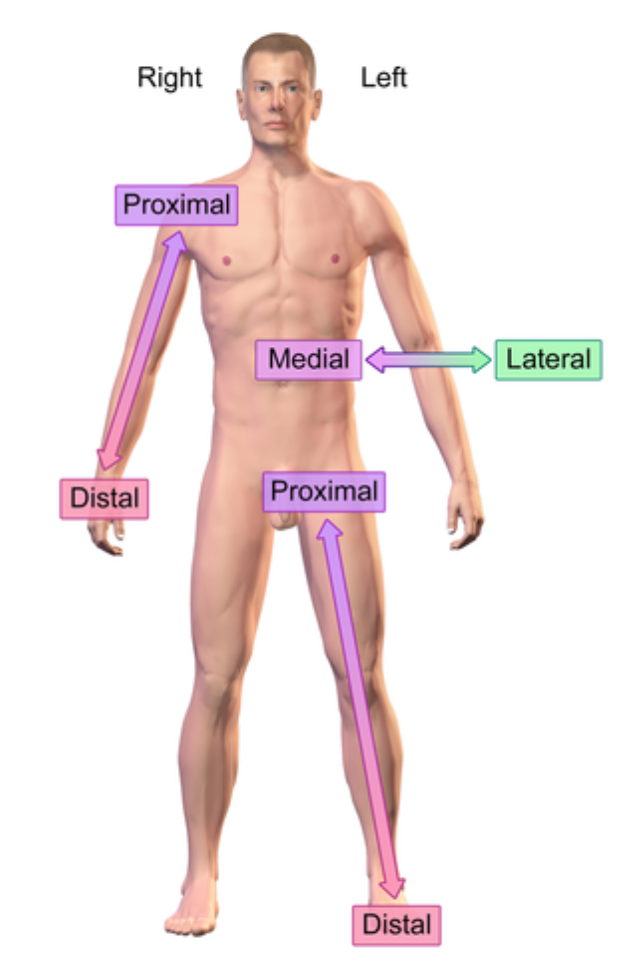
Medial (anatomical term)
Closer into the midline
e.x: eye is medial to the ear
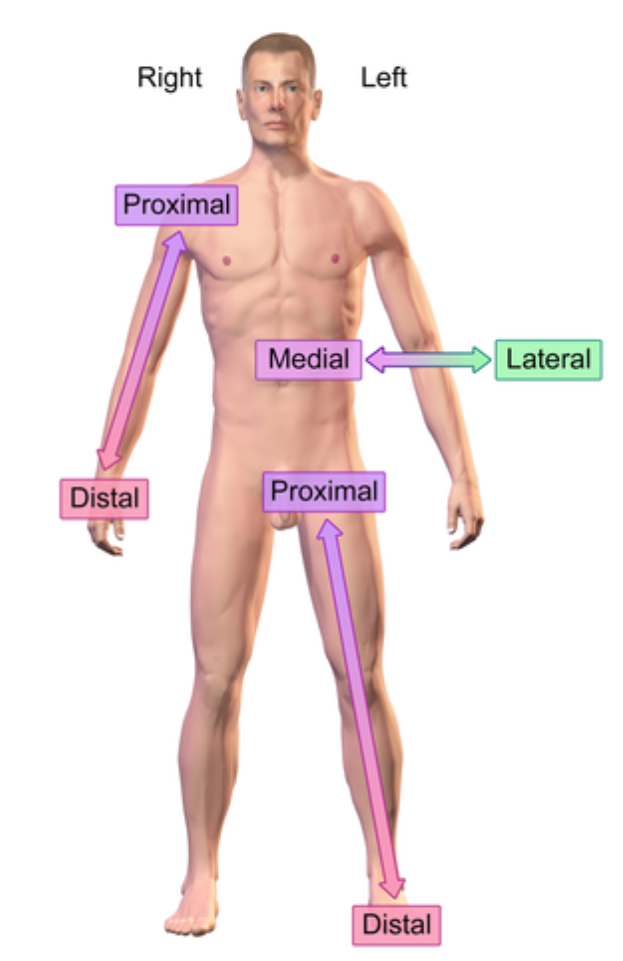
Distal (anatomical term)
further from the point of origin
e.x: Wrist distal to elbow (point of origin is shoulder)

Proximal (anatomical term)
e.x: Elbow proximal to wrist (point of origin is shoulder)
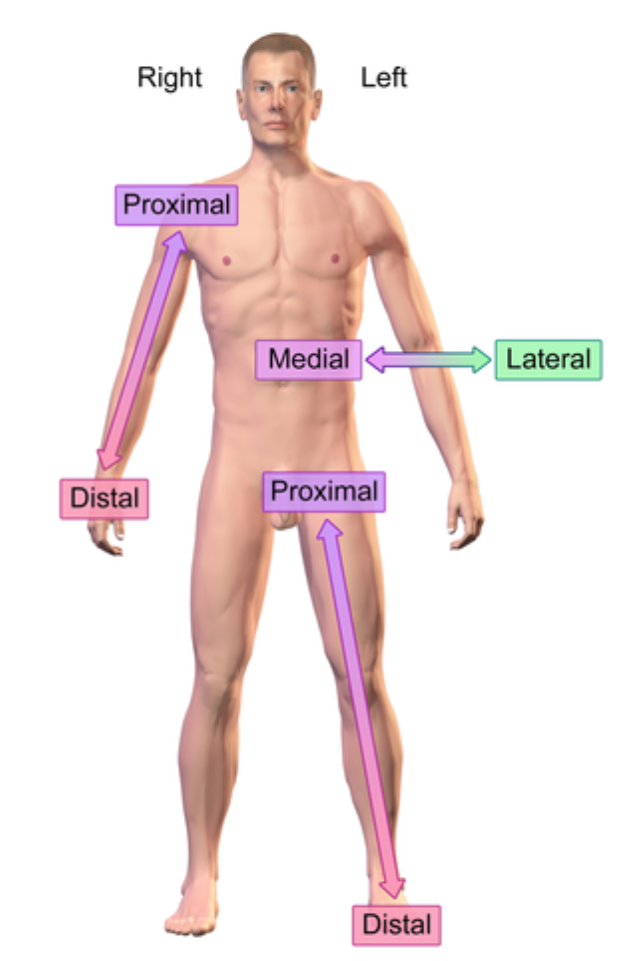
Deep (anatomical term)
Further from skin
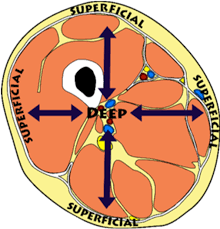
Superficial (anatomical term)
Closest to skin
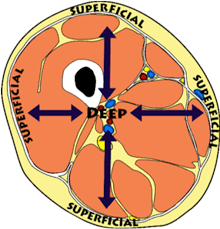
Superior (anatomical term)
On top of
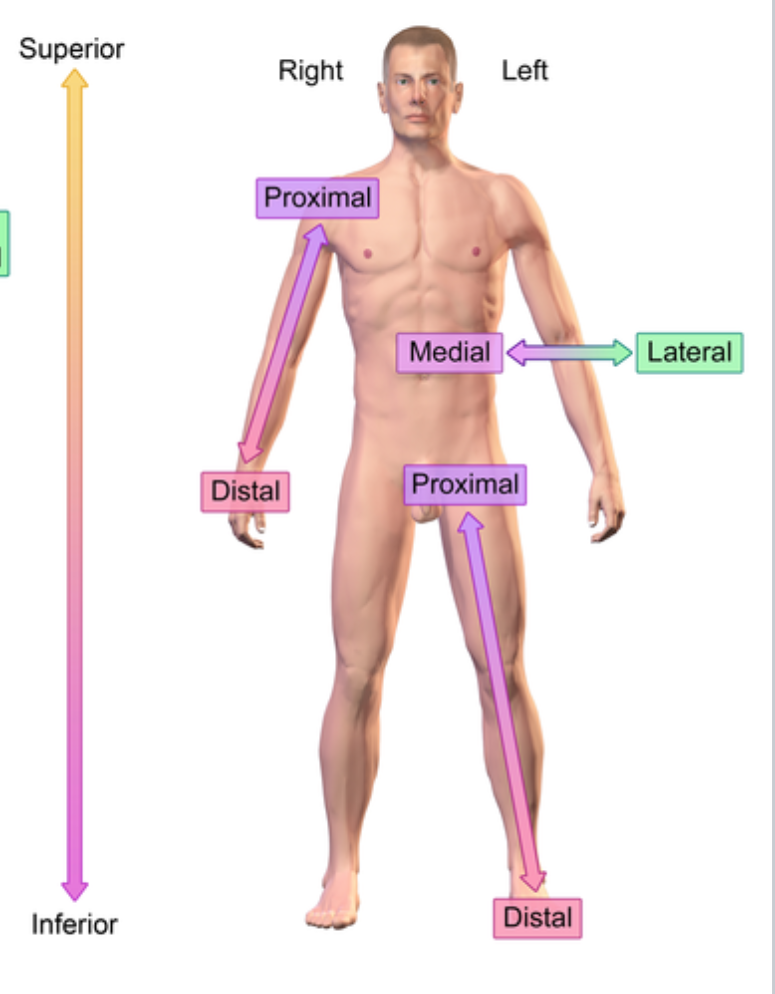
Inferior (anatomical term)
Below
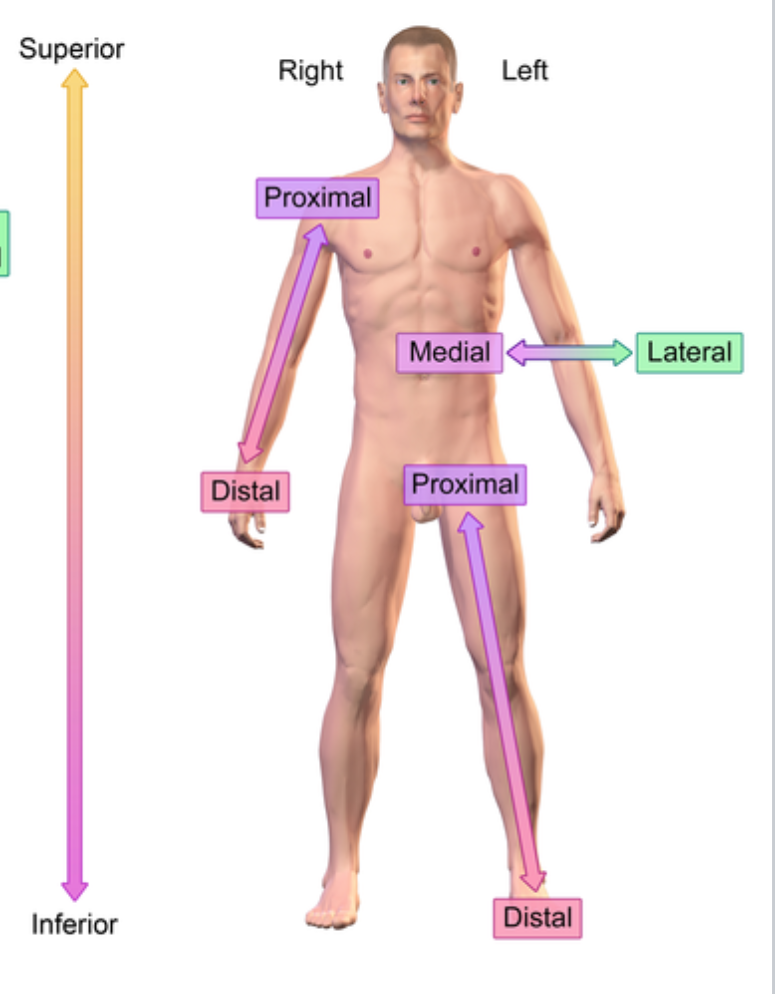
Body planes
Sagittal
Transverse
Frontal
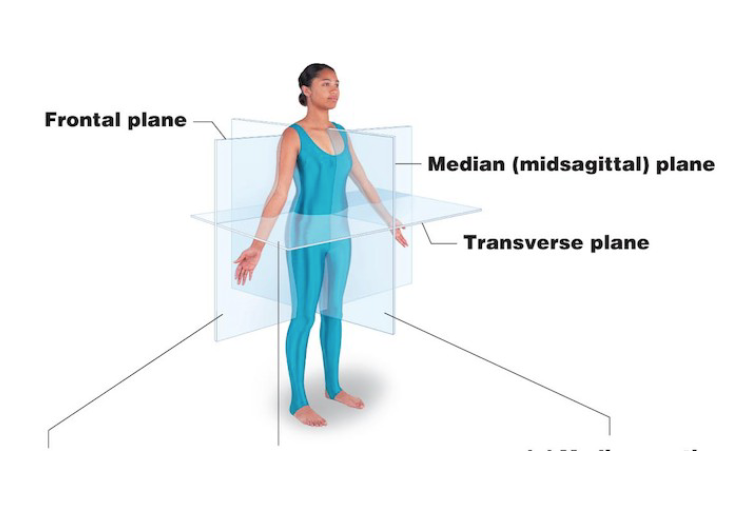
Sagittal
Divides body into left and right
Median/midsagittal plane divides the body exactly in half
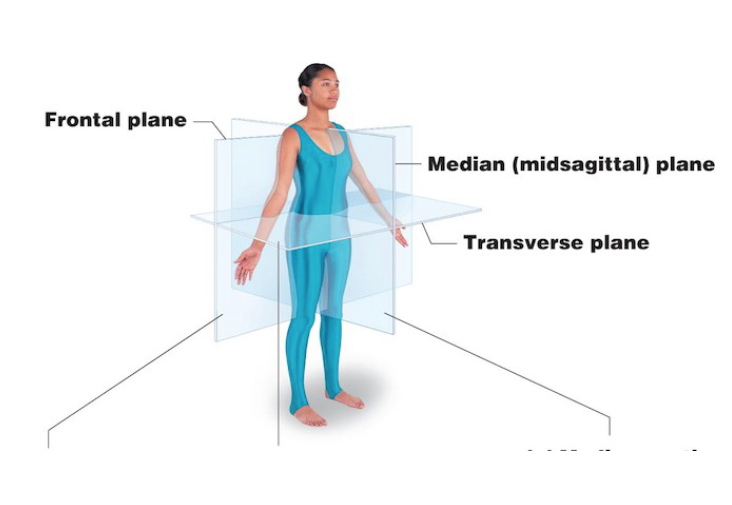
Frontal
Divides body into anterior and posterior

Transverse
Divides body in superior and inferior parts
Cross section
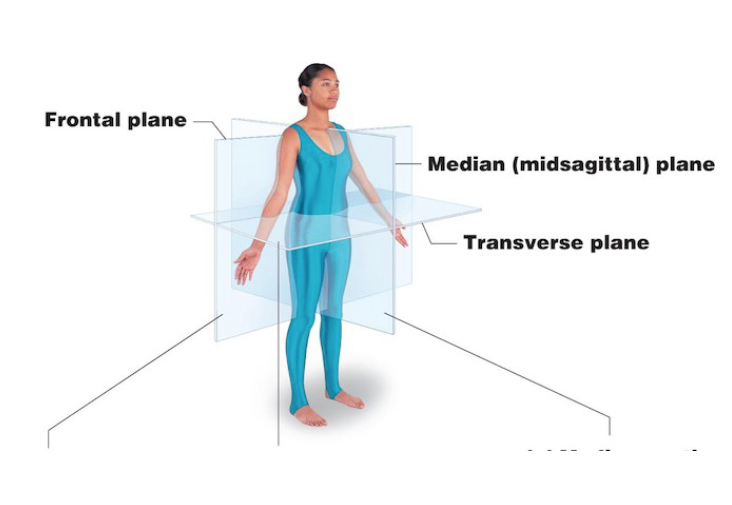
Body cavities
Most organs are found in one of the body cavities
Dorsal body cavity
Ventral body cavity
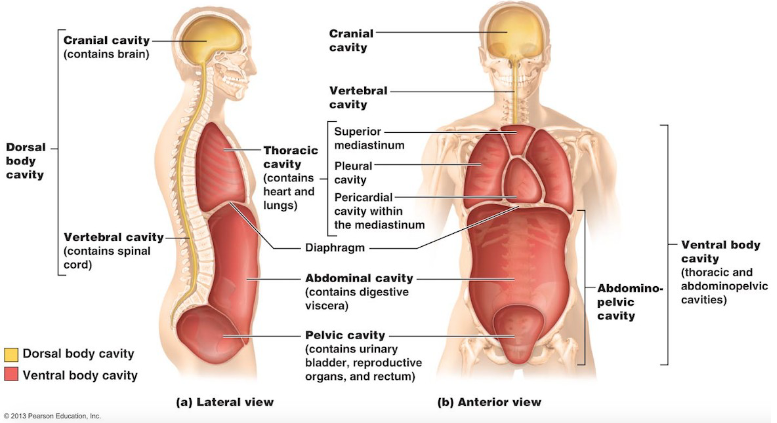
Dorsal body cavity
Protects organs of central nervous system
Composed of the cranial cavity and spinal
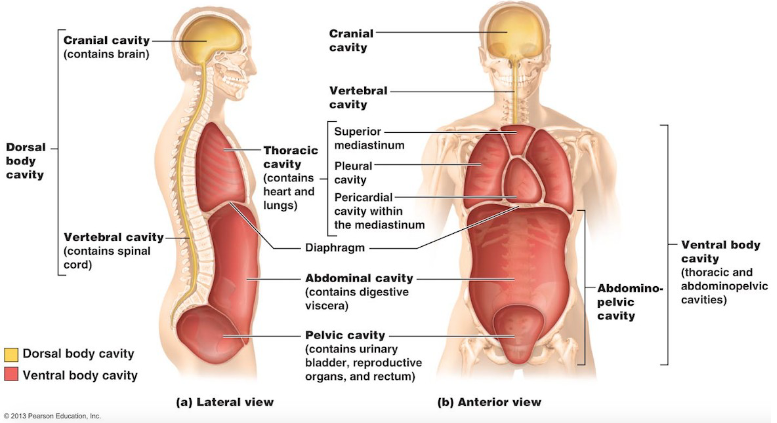
Ventral body cavity
houses visceral organs
Composed of:
Thoracic cavity: contains heart and lungs
Abdominopelvic cavity: separated from thoracic cavity by diaphragm
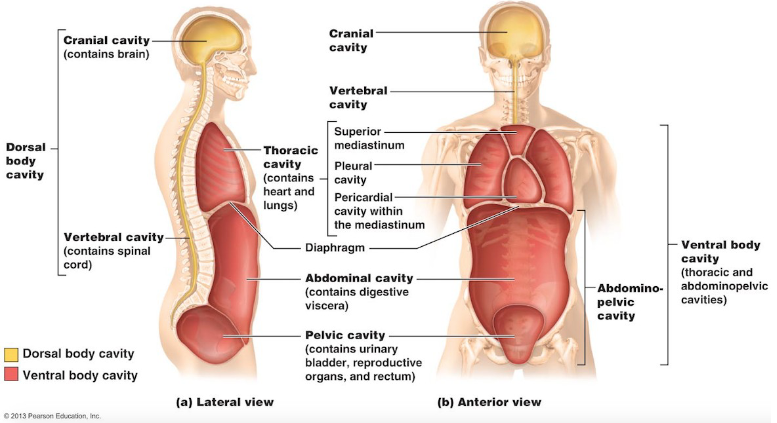
Membranes of the ventral body
Serous membrane
double-layered membrane
Serous membrane
Layers:
Visceral serosa: innermost layer covering the organ
Parietal serosa: outer layer lining the body wall of the cavity
layers are separated by a small amount of serous fluid
Named according to their location
Pericardium: surrounds heart
Pleura: surrounds lungs
Peritoneum: surrounds most organs of the abdominopelvic cavity
Visceral serosa
Innermost layer covering the organ
Parietal serosa
Outer layer lining the body wall of the cavity
Pericardium
Serous membranes surrounding the heart
Pleura
Serous membranes surrounding the lungs
Peritoneum
Serous membranes surrounding most organs of the abdominopelvic cavity
Do all organs have a serous membrane?
No, but most do
ex: Kidneys and esophagus do not